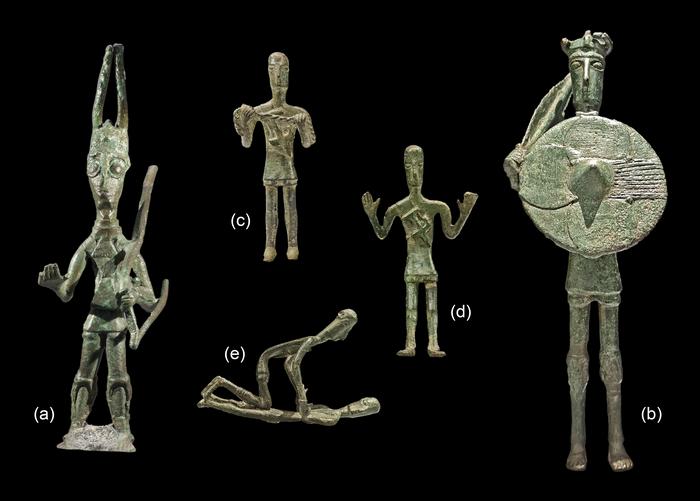Recent research into the tiny bronze figurines of Sardinia’s Nuragic civilization, dating back to around 1000 BCE, has unveiled an intricate web of ancient Mediterranean metal trading networks. These diminutive artefacts, far from mere decorative objects, serve as crucial evidence of extensive cultural and economic exchanges that shaped the early first millennium BCE. Through sophisticated multiproxy analytical techniques, researchers have begun to decipher the origins, fabrication methods, and broader socio-economic contexts of these enigmatic objects, shedding light on the complex metal-driven interactions that connected societies across the Mediterranean basin.
Sardinia, an island situated strategically in the central Mediterranean, was home to the Nuragic culture, known for its architectural monuments and metalwork. The bronze figurines, small in size but rich in symbolic meaning, are part of what is commonly referred to as the Uta-Abini style. These pieces have long intrigued archaeologists because they represent an intersection of artistry, metallurgical skill, and cultural exchange. The latest study undertook a detailed multiproxy approach—integrating metallurgical analyses, lead and isotopic provenance studies, and chronological assessments—to trace both the raw material sources and the technological pathways utilized in the crafting of these figures.
By examining the elemental and isotopic composition of the bronze alloys, researchers discovered a pattern of metal mixing that goes beyond local procurement. The involvement of distant Mediterranean metal sources implies that Nuragic Sardinia was embedded in expansive trade networks. These networks likely facilitated not just the exchange of metals, but also technological knowledge and cultural motifs, revealing a dynamic interconnectedness long before the classical Mediterranean civilization ascended to prominence.
The analytical framework employed combined state-of-the-art techniques such as laser ablation inductively coupled plasma mass spectrometry (LA-ICP-MS) and scanning electron microscopy (SEM), enabling the team to decode metallurgical fingerprints at an unprecedented resolution. This multiproxy approach allowed them to distinguish between different phases of metal production—from ore mining and smelting to casting and alloying practices—thereby reconstructing a comprehensive fabrication biography of each artifact.
Significantly, the study identified distinct fabrication biographies among figurines attributed to different archaeological sites within Sardinia. This finding highlights localized metallurgical traditions while simultaneously reflecting shared technological conventions diffused through metal trade and social networks. The variation in alloy compositions and microstructures points to a nuanced practice of metal recycling and mixing, suggesting that Nuragic metalworkers strategically combined various metal sources to optimize the functional and aesthetic properties of their creations.
The figurines themselves, often depicting anthropomorphic or zoomorphic forms, may have served multifaceted roles within Nuragic society, possibly functioning as ritual objects, status symbols, or markers of identity. Their manufacture was not a peripheral craft but a deliberate, technologically sophisticated activity embedded in broader social and economic rituals. The integration of metal sourcing data with archaeological context provides new perspectives on how such objects mediated interaction and cultural connectivity.
Furthermore, this research challenges long-standing assumptions that isolated island communities exhibited predominantly localized economies. Instead, Sardinia’s metalwork reveals participation in a complex Mediterranean metallurgical landscape, where metal ores, artisans, ideas, and finished products circulated dynamically. Such findings have profound implications for understanding the early development of trade networks, technological transmission, and cultural hybridization in prehistoric Europe.
Importantly, the study also contextualizes these findings within the broader framework of early Mediterranean metallurgy. By comparing Sardinian artifacts with contemporaneous metal objects from mainland Italy and other parts of the Mediterranean, researchers demonstrated both convergence and divergence in metallurgical techniques. This comparative approach underscores the Nuragic civilization’s distinctiveness while simultaneously positioning it within a larger tapestry of interregional exchanges.
The nuanced understanding of Nuragic bronze figurine production and distribution contributes to our comprehension of technological innovation as a driver of early Mediterranean connectivity. It provides evidence for intentional mixing strategies that not only optimized material properties but may also have symbolized social alliances and cultural affiliations. This comprehensive investigation thus redefines the technological and cultural agency of Nuragic metalworkers.
In sum, this groundbreaking multiproxy analysis reconstructs the fabrication biographies of Sardinian bronze figurines, revealing a sophisticated interplay of local craftsmanship and Mediterranean metal trade. It illuminates how metalwork was a medium through which early societies negotiated identity, power, and interaction. Such revelations expand our historical narrative of prehistoric Europe, opening new avenues for exploring the complexities of ancient technological and social systems.
As these insights emerge from the amalgamation of advanced scientific analyses and archaeological inquiry, they prompt a reevaluation of the Nuragic civilization’s role in Mediterranean prehistory. The evidence advocates for a model of ancient Sardinia not as an isolated culture, but as an active participant in a vibrant network of exchange and innovation, deeply embedded in the metal economies that underpinned early complex societies.
Looking forward, this study exemplifies the transformative potential of interdisciplinary research in archaeology, where materials science converges with cultural studies to decode the past. It also sets a precedent for similar multiproxy approaches to other ancient materials, promoting a richer understanding of the technological biographies that define human history.
Subject of Research: Multiproxy analysis of Sardinian Nuragic bronze figurines revealing origins, fabrication, and metal trade networks in the early first millennium BCE.
Article Title: Multiproxy analysis unwraps origin and fabrication biographies of Sardinian figurines: On the trail of metal-driven interaction and mixing practices in the early first millennium BCE
News Publication Date: 10-Sep-2025
Web References:
- Article URL: http://plos.io/45QCTPq
- DOI: http://dx.doi.org/10.1371/journal.pone.0328268
- Funding source: Augustinus Foundation, Metals & Giants project (https://augustinusfonden.dk/en)
References: Berger et al., 2025, PLOS One, CC-BY 4.0 (https://creativecommons.org/licenses/by/4.0/)
Image Credits: Berger et al., 2025, PLOS One, CC-BY 4.0 (photos: HW Nørgaard, D Berger)
Keywords: Nuragic civilization, Sardinian bronze figurines, early Mediterranean metallurgy, multiproxy analysis, metal trade networks, isotopic provenance, alloy composition, prehistoric archaeology, metalworking techniques, archaeological metallurgy, Sardinia, Bronze Age




